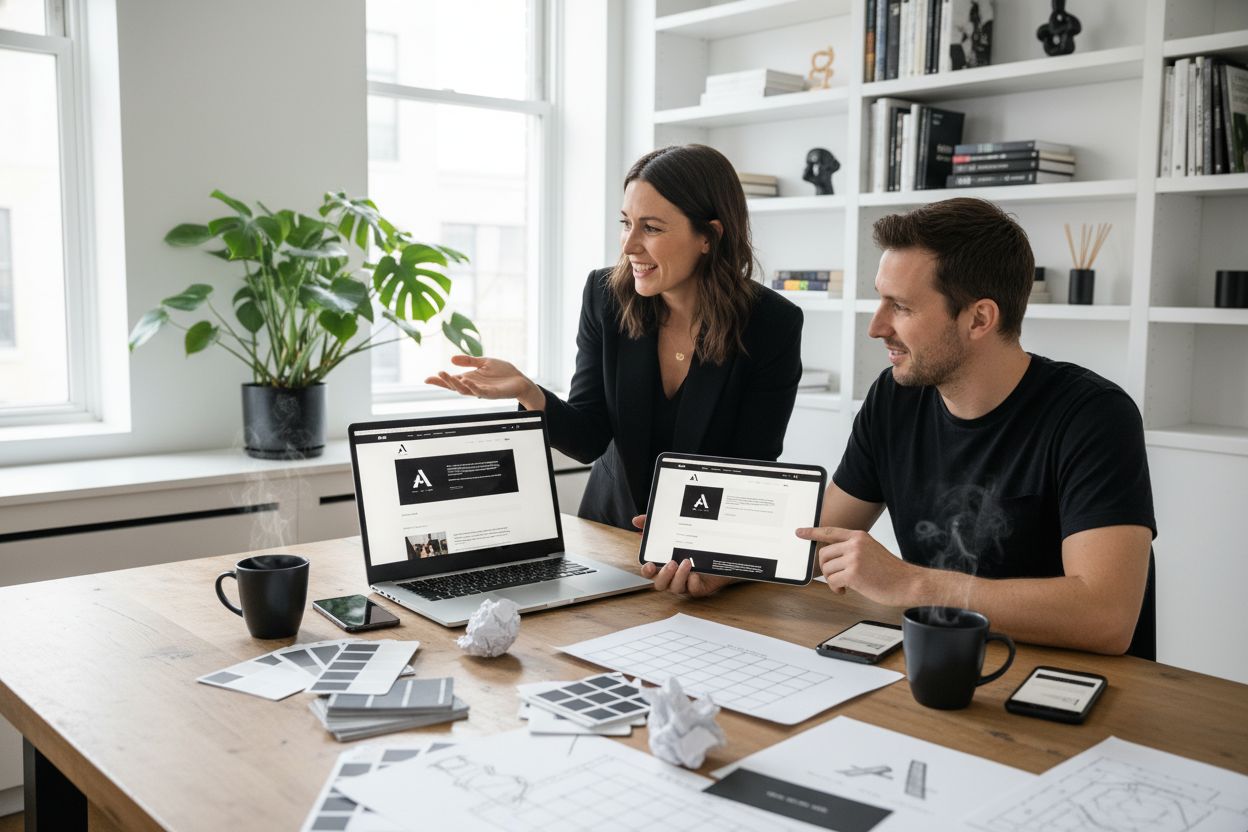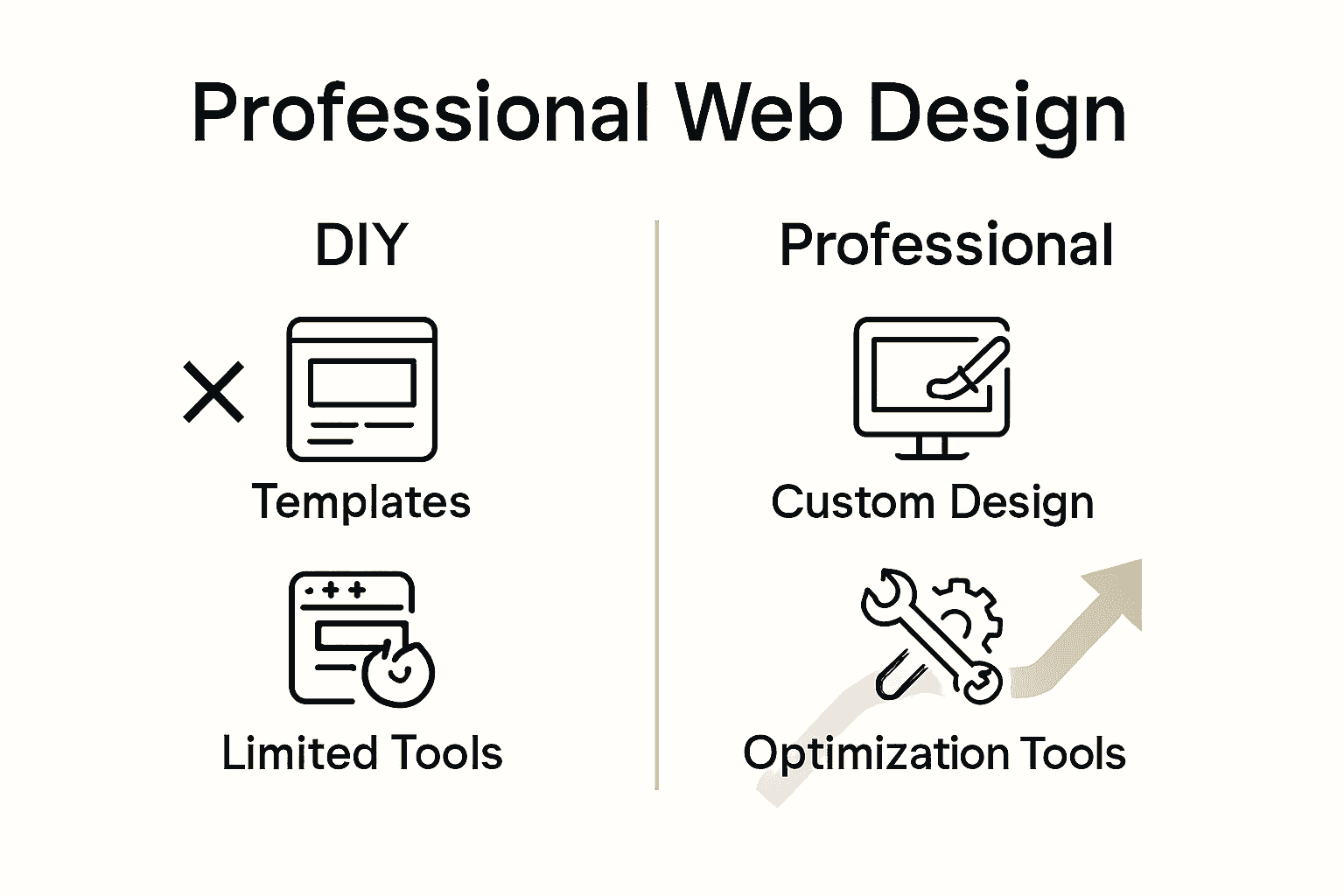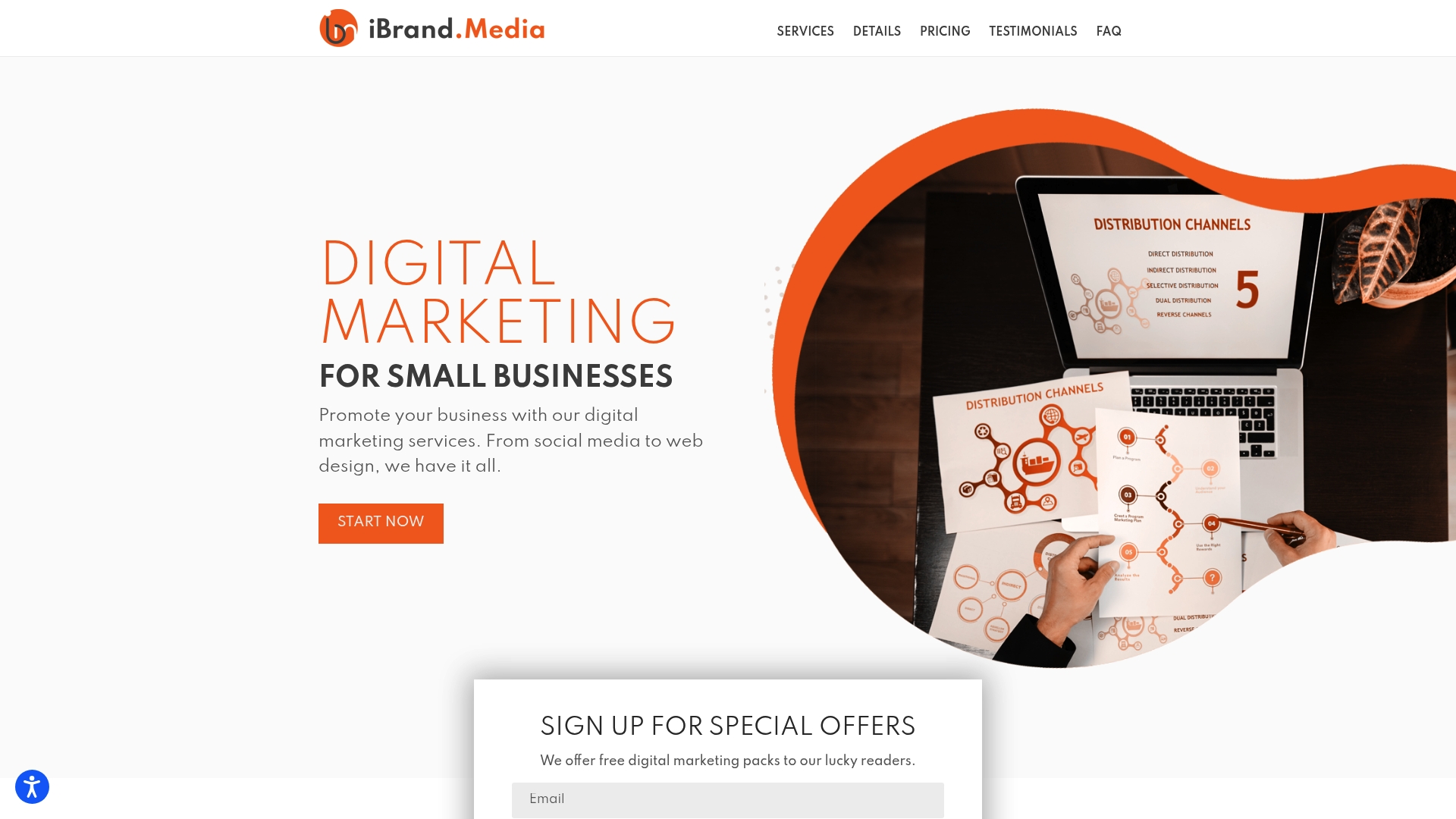Did you know that nearly 75% of users judge a company’s credibility based on its website design? A well-crafted site is no longer just about looking modern—it shapes how customers trust and choose your business. With online competition fierce, every detail of your web presence matters. By understanding what sets successful web design apart, you can create a digital storefront that draws in visitors and keeps your brand at the top of their minds.
Key Takeaways
| Point | Details |
|---|---|
| Holistic Approach to Web Design | Modern web design combines aesthetics, technology, and user experience for effective business communication online. |
| Professional Design as a Competitive Advantage | Investing in quality web design enhances credibility, user experience, and conversion rates, making it vital for small business success. |
| Essential Features for Success | Key elements like intuitive navigation, SEO optimization, and compelling calls-to-action are crucial for converting visitors into customers. |
| DIY vs. Professional | While DIY options may be cost-effective, professional web design ensures customization, advanced features, and better long-term ROI. |
Table of Contents
- Defining Web Design For Modern Businesses
- Core Benefits Of Professional Web Design
- Key Features That Drive Online Success
- Comparing Diy Vs. Professional Web Design
- Evaluating Costs, Roi, And Budget Factors
Defining Web Design for Modern Businesses
Web design today is far more than just creating a visually appealing website. It’s a strategic blend of aesthetics, technology, and user experience that transforms how small businesses communicate and connect with their audience online. Web design represents the comprehensive process of planning, conceptualizing, and arranging content for digital platforms.
According to the Stanford Web Credibility Project, design profoundly influences user trust and perception. A well-crafted website can dramatically sway potential customers’ views of your business’s legitimacy and professionalism. Key elements that contribute to this perception include:
- Clean, intuitive navigation
- Professional color schemes
- Responsive layout
- High-quality imagery
- Fast loading times
Modern web design is increasingly integrating advanced technologies to create more engaging digital experiences. Our guide on understanding user experience in web design explores how emerging trends like AI-driven personalization, dark mode interfaces, and micro-interactions are reshaping how businesses connect with online audiences. These technologies aren’t just aesthetic choices—they’re strategic tools that can significantly enhance user engagement and conversion rates.
For small businesses, investing in thoughtful web design isn’t a luxury—it’s a critical competitive advantage. Your website serves as your digital storefront, often forming the first impression potential customers will have of your brand. A strategic, well-executed design communicates professionalism, builds trust, and creates meaningful connections with your target audience.

Core Benefits of Professional Web Design
Investing in professional web design transforms your digital presence from a mere online placeholder to a powerful business growth engine. Small businesses often underestimate the strategic impact a well-crafted website can deliver, viewing it as an optional expense rather than a critical marketing asset. The reality is that your website serves as your 24/7 digital storefront, working continuously to attract, engage, and convert potential customers.
The core benefits of professional web design extend far beyond aesthetic appeal. They directly influence critical business outcomes:
- Credibility Enhancement: A polished, modern design signals professionalism and trustworthiness
- Improved User Experience: Intuitive navigation reduces bounce rates and increases engagement
- Mobile Responsiveness: Ensures seamless interaction across all device types
- Search Engine Optimization (SEO): Clean, structured design improves search rankings
- Conversion Optimization: Strategic layout and design elements guide users toward key actions
Our guide on website design basics for local businesses offers deeper insights into how strategic design can transform your digital strategy. Professional web designers understand that every visual element, from color schemes to button placements, plays a crucial role in user psychology and decision-making.
Moreover, a professionally designed website provides a competitive edge in crowded markets. It’s not just about looking good—it’s about creating a digital experience that communicates your brand’s unique value proposition, builds trust instantly, and turns website visitors into loyal customers. In today’s digital landscape, your website is often the first interaction potential clients have with your business, making professional design an investment in your brand’s future success.
Key Features That Drive Online Success
Successful web design goes beyond visual appeal—it requires strategic features that transform your digital presence into a powerful business tool. Essential web features are the critical components that bridge the gap between attracting visitors and converting them into loyal customers.
According to research from Footprint’s web design analysis, several key features drive online success for small businesses:
- Intuitive Navigation: Clear, logical site structure that helps users find information quickly
- Compelling Calls-to-Action: Strategic buttons and prompts that guide user engagement
- E-commerce Capabilities: Secure, user-friendly shopping experiences
- SEO-Friendly Structure: Optimized content and technical elements for search visibility
- Responsive Design: Seamless experience across desktop, tablet, and mobile devices
Emerging technologies are reshaping web design capabilities. Our guide on targeting local customers online highlights how innovative features like AI personalization and voice search optimization can provide a competitive edge. According to recent research, forward-thinking businesses are now incorporating advanced elements such as:
- Artificial intelligence-driven personalization
- Voice search optimization
- Augmented reality (AR) interactive experiences
- Eco-friendly design practices like energy-efficient hosting
Ultimately, the most successful websites are those that seamlessly blend technical functionality with intuitive user experience. Your online platform should not just look good—it must work intelligently, anticipate user needs, and create smooth, engaging digital interactions that turn visitors into customers.
Comparing DIY vs. Professional Web Design
Choosing between do-it-yourself (DIY) web design and professional web design is a critical decision that can significantly impact your business’s online success. While DIY platforms offer tempting low-cost solutions, they often come with hidden limitations that can hinder your digital growth strategy.
DIY Web Design Pros and Cons
DIY Advantages:
- Lower upfront costs
- Immediate control over design
- Flexible editing options
- No dependency on external designers
DIY Limitations:
- Limited design capabilities
- Generic, non-unique templates
- Potential technical challenges
- Reduced professional polish
- Limited customization options
Professional Web Design Benefits
Professional web designers bring specialized expertise that transforms your digital presence. Our guide on understanding DIY marketing versus agency support illustrates how professional intervention can dramatically elevate your online strategy. They offer:
- Custom design tailored to your brand
- Advanced technical optimization
- Strategic user experience planning
- SEO-integrated design
- Responsive, cross-device compatibility
Ultimately, your website represents your business’s digital identity. While DIY solutions might seem cost-effective initially, professional web design is an investment that pays long-term dividends. Professional designers understand that effective web design isn’t just about looking good—it’s about creating a strategic digital platform that attracts, engages, and converts potential customers.
 For small businesses seeking to establish a strong, credible online presence, the expertise of a professional web design team can make the critical difference between blending in and standing out.
For small businesses seeking to establish a strong, credible online presence, the expertise of a professional web design team can make the critical difference between blending in and standing out.
Here’s a comparison of DIY vs. Professional Web Design:
| Aspect | DIY Web Design | Professional Web Design |
|---|---|---|
| Upfront Cost | Low | Moderate to High |
| Customization | Limited Template-based |
High Brand-tailored |
| Technical Skills Needed | Basic | Minimal (handled by experts) |
| Design Quality | Basic Generic |
Advanced Unique |
| SEO Optimization | Minimal | Integrated & Strategic |
| Ongoing Support | Self-managed | Included Or optional |
| Time Investment | High (do-it-yourself) | Low (delegated) |
Evaluating Costs, ROI, and Budget Factors
Understanding the financial implications of web design is crucial for small businesses navigating limited budgets and seeking maximum return on investment (ROI). Web design isn’t an expense—it’s a strategic investment that directly impacts your business’s digital performance and bottom line.
According to recent research, small businesses with professional websites report a remarkable 53% higher success rate. This statistic isn’t just about looking good online—it translates into tangible business outcomes:
- Increased Visibility: Better search rankings
- Enhanced Credibility: Professional first impressions
- Higher Conversion Rates: More effective user journeys
- Customer Satisfaction: Intuitive, user-friendly experiences
- Revenue Growth: Direct correlation with professional digital presence
Budget Breakdown
Typical web design investment for small businesses ranges from $1,000 to $5,000, depending on complexity. Learn more about affordable digital marketing strategies for small businesses to understand how to maximize your budget. Key budget considerations include:
- Design Complexity
- Custom vs. Template Approaches
- Ongoing Maintenance Costs
- Integration of Advanced Features
- SEO and Performance Optimization
Your website is essentially a 24/7 digital employee—working continuously to attract, engage, and convert potential customers. While the upfront investment might seem significant, the long-term benefits far outweigh initial costs. Smart businesses view web design as a critical marketing asset that delivers continuous returns, not just a one-time expense.
Transform Your Business with Professional Web Design Solutions
Your business deserves more than just an online placeholder. If you have struggled with limited website results, lack of credibility, or difficulty standing out in your local market, it is time for a change. As discussed in this article, professional web design is a key driver of trust, higher rankings, and better conversion rates. Small businesses can gain a huge edge by investing in custom, mobile-friendly websites that turn visitors into loyal customers. Discover how dedicated design backed by strategic digital marketing can elevate your entire brand presence.

Ready to take your first step toward a website that works as hard as you do? See how ibrand.media partners with small and medium-sized businesses to deliver affordable, results-driven web design and marketing. Visit our Uncategorized | Ibrandmedia section for real examples of business growth or go directly to ibrand.media to request a free consultation. Act now and let us build a digital platform that attracts, inspires, and converts.
Frequently Asked Questions
What are the core benefits of professional web design for small businesses?
Investing in professional web design enhances credibility, improves user experience, ensures mobile responsiveness, supports SEO efforts, and optimizes conversion rates. These benefits collectively empower businesses to engage and convert visitors effectively.
How does web design influence user trust and perception?
According to research, a well-crafted website can significantly sway customer perceptions about a business’s legitimacy and professionalism, as elements like intuitive navigation and a polished design create an impression of trustworthiness.
What features should I include in my small business website?
Essential features to consider include intuitive navigation, compelling calls-to-action, e-commerce capabilities, SEO-friendly structure, and responsive design, all of which are crucial for user engagement and conversion.
How do DIY and professional web design compare in terms of effectiveness?
DIY web design often comes with limitations such as generic templates and basic capabilities, while professional web design offers custom solutions, advanced optimization, and strategic user experience planning, resulting in more effective and unique web presences.
Recommended
- 10 Essential Website Design Best Practices for Small Businesses | Ibrandmedia
- Building a Business Website: Your 2025 Step-by-Step Guide | Ibrandmedia
- Understanding Website Design Basics for Local Businesses | Ibrandmedia
- 10 Essential Website Design Tips for Small Businesses | Ibrandmedia
- Design And Development Subscription – New Trend? | Markupus
- Effective Website Design: Key Principles and Proven Strategies 2025

Recent Comments